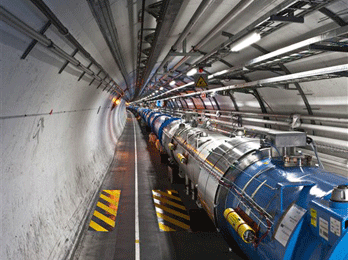CERN announces the discovery of a new particle consistent with the Higgs Boson

04/07/2012
These preliminary results will be presented on Saturday to the international scientific community at the most important conference on particle physics, the ICHEP2012 in Melbourne. Although they are not the definite results, and that in the next few weeks researchers will prepare their publication, the data clearly demonstrates the existence of a new particle, with a statistic level of confidence of 5 sigmas - the threshold of a discovery according the scientists.
As explained by IFAE researcher Martine Bosman, President of the ATLAS Experiment Council, "many of us physics have grown old while constructing and analysing the data generated by the experiments while searching for the Higgs boson. Now we have found a new particle and some of its characteristics are the same as we suspected to exist with Higgs! In the following weeks and months we will measure more closely its properties and will slowly reveal its true nature."
The fact remains that what was observed by the CERN is definitely a boson and that it is the most massive boson to be found to date. But, what must yet be done to confirm that this is the Higgs boson? ICREA researcher Mario Martínez explains: "we must look at the data with a magnifying glass. The data we have analysed up to now are those compiled by the experiments in 2011 and 2012, but we will have even more by the end of the year. Moreover, we have only searched for Higgs in two of the channels in which we know it could be found. To make sure it is the Higgs boson and not some other particle, we must observe it and check for all possible signals we know the detector should be picking up."
The Higgs discovery was until now the missing link in the Standard Model of Particle Physics, a model which - with a precision almost unique in science - would help us understand our universe and matter. But we also knew that many particles have matter, and to explain this with this model we needed the existence of a particle which we had not yet been able to observe: the Higgs Boson.
Once the results are published at the end of July, new data will be collected from the Large Hadron Collider (LHC) accelerator, which will continue to collect data at least until the end of this year. The data and future analysis will allow us to discover more details about this particle. Is it really the Higgs from the Standard Model, or could it be an even more exotic particle which opens the door to a new physics?
A more exotic Higgs which does not fully fit in the model, could be related to the discovery of the origins of dark matter. The matter we see in the universe seems to be only 4% of the total of matter existing. If the particle observed at CERN is an exotic Higgs boson, it may help us understand not only the origin of particles we are already familiar with, but also the origin of the 96% of matter we do not yet understand.
Since 1993, IFAE has actively collaborated in the construction and functioning of the ATLAS detector, in the studies in physics and in institutional aspects of this collaboration. Specifically, the group constructed one of the three "barrels" of the hadron calorimeter, formed by 64 modules weighing 11 tonnes each. They were also in charge of its electronic calibration and the design of part of the software to filter events which is used in the process of data acquisition. They are currently developing cutting-edge silicon detectors to be implemented in the second performance phase of the project. IFAE conducts a very complete programme in physics, with measures that test the predictions of the Standard Model and are increasingly sensitive to the possible presence of new physics. These studies include the research in Higgs boson in its mode of decay into bottom quarks. IFAE is also very present in the organisation of this collaboration. For example, since its creation, the collaboration council has been presided twice by a member of IFAE.
The analysis of data would not be possible without the LHC data processing system, which to date is the system with the largest capacity of the world. It is located near CERN and in 11 Tier-1 level centres directly connected to CERN through high-capacity optical fibres. One of these centres is the PIC centre (Port d'Informació Científica), located at Universitat Autònoma de Barcelona.